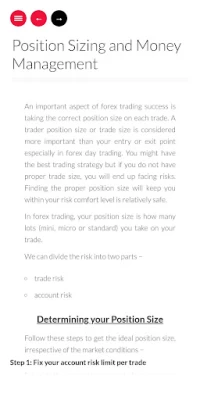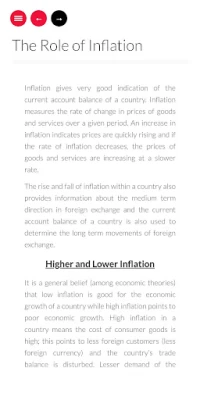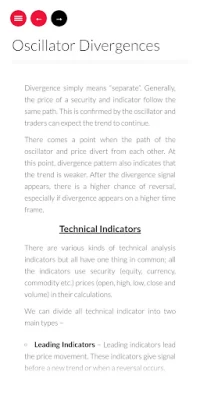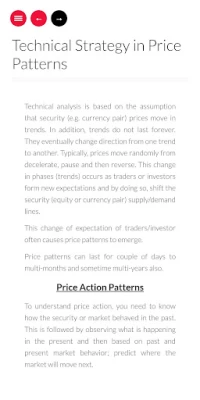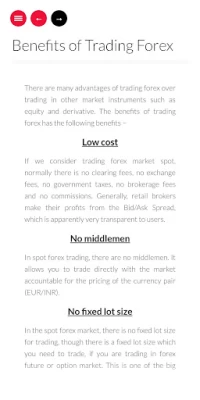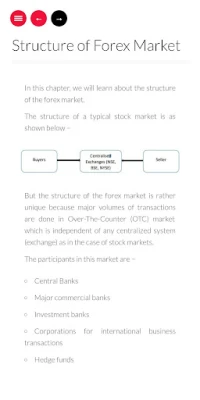
Latest Version
1.0.1
September 24, 2025
Incognito Inventions
Education
Android
0
Free
lifegoal.helpinghands.forextrading
Report a Problem
More About Learn Forex Trading
Mastering Forex Trading: A Comprehensive Guide for Students
Forex trading offers an invaluable opportunity for students to learn the intricacies of trading, progressing from fundamental concepts to advanced strategies. This guide is designed to provide a structured approach to mastering forex trading, ensuring that learners can navigate the complexities of the foreign exchange market with confidence.
Key Features of Our Forex Trading Course
- Completely Free of Charge
- Comprehensive Forex Trading Basics
- Advanced Forex Trading Techniques
- Offline Tutorials for Flexible Learning
Forex Trading Basic Tutorial
1. Introduction to Forex Trading
Forex trading, or foreign exchange trading, involves the buying and selling of currencies in a global marketplace. Understanding the basics is crucial for anyone looking to enter this dynamic field.
2. The Structure of the Forex Market
The forex market operates 24 hours a day, five days a week, and is decentralized, meaning it does not have a physical location. Instead, trading occurs electronically over-the-counter (OTC) through a network of banks, brokers, and financial institutions.
3. Major Currencies and Trade Systems
Familiarity with major currencies such as the US Dollar (USD), Euro (EUR), and Japanese Yen (JPY) is essential. Understanding how these currencies interact within various trading systems will enhance your trading strategies.
4. Types of Market Analysis
Successful forex trading relies on two primary types of analysis: fundamental and technical. Each method provides unique insights into market movements and potential trading opportunities.
5. Kinds of Foreign Exchange Markets
There are several types of forex markets, including spot markets, futures markets, and options markets. Each serves different purposes and offers various trading opportunities.
6. Benefits of Trading Forex
Forex trading offers numerous advantages, including high liquidity, the ability to trade on margin, and the potential for profit in both rising and falling markets.
7. Fundamental Market Forces
Understanding the fundamental forces that drive currency values, such as economic indicators, interest rates, and geopolitical events, is vital for making informed trading decisions.
8. Technical Indicators
Technical indicators, such as moving averages and Relative Strength Index (RSI), help traders analyze price movements and identify potential entry and exit points.
9. Pattern Study of Trends, Support, and Resistance
Recognizing patterns in price movements, including trends, support, and resistance levels, is crucial for predicting future market behavior.
10. Technical Strategy in Price Patterns
Developing a technical strategy based on price patterns can enhance your trading effectiveness. This involves identifying key patterns that signal potential market movements.
11. Oscillator Divergences
Oscillator divergences occur when the price of a currency pair moves in the opposite direction of an oscillator indicator. Recognizing these divergences can provide valuable trading signals.
12. The Role of Inflation
Inflation plays a significant role in currency valuation. Understanding how inflation affects currency strength can help traders make more informed decisions.
13. The Commodity Connection
The relationship between commodities and currencies is essential. Many currencies are influenced by the prices of commodities, such as oil and gold, making it important for traders to stay informed about these connections.
14. Position Sizing and Money Management
Effective position sizing and money management strategies are critical for minimizing risk and maximizing potential returns in forex trading.
15. Foreign Exchange Risks
Forex trading involves various risks, including market risk, liquidity risk, and credit risk. Understanding these risks is essential for developing a robust trading strategy.
16. Trading Rules to Live By
Establishing a set of trading rules can help maintain discipline and consistency in your trading approach. Key rules include setting stop-loss orders, avoiding emotional trading, and continuously educating yourself.
Conclusion
Forex trading is a complex yet rewarding endeavor that requires a solid understanding of market dynamics and trading strategies. By following this comprehensive guide, students can build a strong foundation in forex trading, equipping themselves with the knowledge and skills necessary to succeed in this exciting field.
Disclaimer: The content provided in this guide is for educational purposes only. It is not intended as financial advice. Please consult with a financial advisor before engaging in forex trading.
Rate the App
User Reviews
Popular Apps










Editor's Choice











